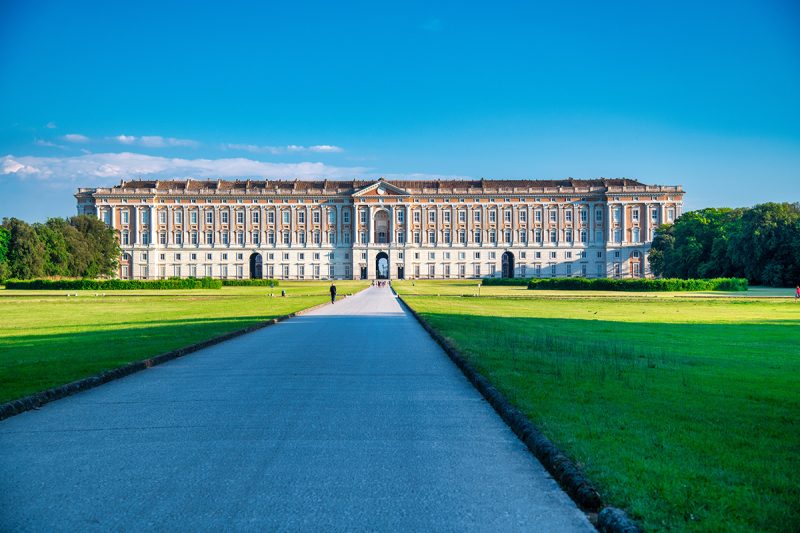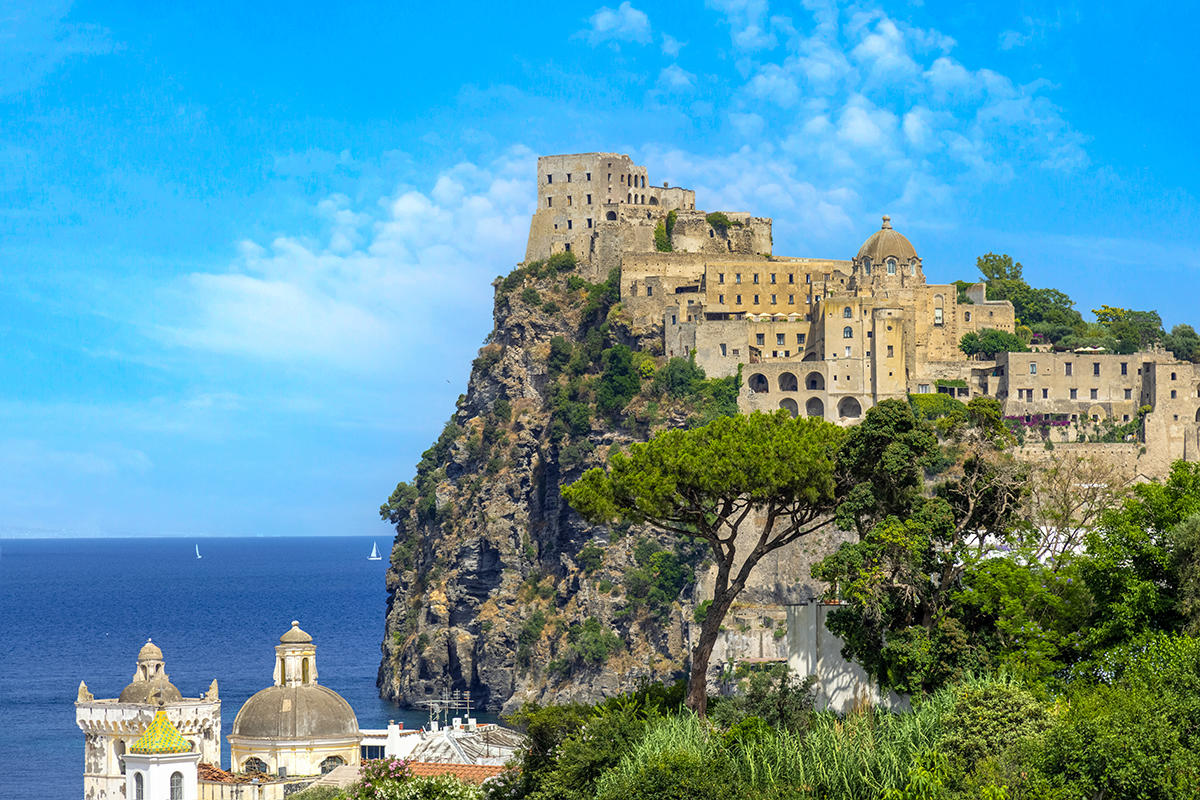From opulent royal residences to mighty fortresses, Italy’s palaces stand as enduring monuments to the nation’s wealthy architectural heritage and noble historical past. These magnificent buildings inform a novel story of energy, artistry, and cultural evolution.
Let’s discover essentially the most gorgeous palaces in Italy that proceed to captivate guests from world wide.
Every of those European palaces gives guests a novel window into Italy’s wealthy cultural heritage, from the opulent life of its noble households to the architectural improvements that influenced buildings all through Europe. Whether or not you’re an structure fanatic, historical past buff, or just somebody who appreciates magnificence, these magnificent buildings deserve a spot on any Italian itinerary.
1. Royal Palace of Caserta
Typically known as the “Italian Versailles,” the Royal Palace of Caserta is a masterpiece of Baroque structure and arguably Italy’s most luxurious royal residence. Commissioned by the Bourbon King Charles III within the 18th century, this UNESCO World Heritage website boasts 1,200 rooms adorned with valuable artworks and frescoes.
The palace’s crowning glory is its spectacular gardens, that includes cascading fountains, elaborate sculptures, and a grand waterway stretching almost two miles. The palace’s architect, Luigi Vanvitelli, created an ingenious system of aqueducts to provide water to the fountains and gardens, a exceptional feat of 18th-century engineering.
The Royal Residences showcase the peak of Neapolitan ornamental arts, with silk wallpapers, intricate ceiling frescoes, and custom-made furnishings nonetheless completely preserved. The palace’s grand staircase, with its marble steps and ornate statuary, stays some of the spectacular architectural options in any European palace.

2. Doge’s Palace, Venice
Venice’s iconic Doge’s Palace exemplifies town’s distinctive Gothic structure and maritime energy. Overlooking St. Mark’s Sq. and the lagoon, this pink and white marble masterpiece served as each the Doge’s residence and the middle of Venetian authorities for hundreds of years.
Its ornate facades, golden staircases, and works by masters like Tintoretto and Veronese make it an unmissable treasure of Italian structure. The palace’s well-known Bridge of Sighs, connecting the palace to its prisons, has turn into one among Venice’s most photographed landmarks.
The Golden Staircase, adorned with pure gold leaf and carved marble, results in the Doge’s personal residences and state rooms. The Chamber of the Nice Council, one of many largest rooms in Europe, options Tintoretto’s “Paradise,” the world’s largest oil portray.


3. Palazzo Pitti, Florence
Initially constructed for the highly effective Pitti household and later house to the Medici dynasty, this large Renaissance palace dominates Florence’s Oltrarno district. Right now, it homes a number of museums showcasing all the pieces from silver treasures to costume collections.
The palace’s Palatine Gallery accommodates a unprecedented assortment of Renaissance and Baroque work, displayed in rooms adorned with elaborate frescoed ceilings and gilt furnishings.
The Royal Residences protect the luxurious decorations from the interval when the palace served as residence to the Kings of Italy. The palace’s distinctive rusticated stone facade, designed by Brunelleschi, influenced palace structure all through Europe.
The Boboli Gardens function an amphitheater carved into the hillside, elaborate grottoes, and fountains that impressed many European royal gardens, together with Versailles. Any Florence journey itinerary ought to embody this beautiful palace.


4. Royal Palace of Turin
As the primary capital of unified Italy, Turin’s Royal Palace represents the magnificent seat of the Home of Savoy. Its lavish State Residences function wealthy baroque decorations, Chinese language lacquer cupboards, and the gorgeous Chapel of the Holy Shroud.
The palace advanced, a part of a UNESCO World Heritage website, demonstrates the architectural grandeur of Europe’s oldest royal dynasty. The Royal Armory homes one of many world’s best collections of arms and armour, whereas the Royal Library accommodates Leonardo da Vinci’s self-portrait and 1000’s of uncommon manuscripts.
The throne room, with its crimson damask partitions and elaborate gilded stucco work, exemplifies the ability and wealth of the Savoy dynasty. The Royal Gardens, not too long ago restored to their unique baroque splendor, present a peaceable retreat within the coronary heart of Turin.


5. Quirinal Palace, Rome
Sitting atop Rome’s highest hill, the Quirinal Palace serves because the official residence of the Italian President. Initially constructed for the papal courtroom, this huge advanced has housed kings and popes all through its historical past.
Its elegant rooms, that includes priceless artworks and tapestries, showcase the evolution of Italian ornamental arts throughout centuries. The Quirinal Gardens, designed within the Sixteenth century, comprise uncommon botanical specimens and historic Roman statuary.
The large Scala del Mascherino, a monumental staircase, demonstrates the architectural genius of the Renaissance. The Corridor of Mirrors, impressed by its Versailles counterpart, displays mild from huge Murano glass chandeliers.


6. Sforza Fortress, Milan
This imposing fortress-palace stands as a logo of Milan’s medieval energy. Constructed by the Sforza dynasty, the constructing, also referred to as Sforzesco Fortress, now homes a number of museums and artwork collections.
These embody Michelangelo’s remaining sculpture, the Rondanini Pietà. Its large partitions and towers proceed to dominate Milan’s historic middle, bridging town’s militant previous with its cultural current.
The fortress’s Sala delle Asse options Leonardo da Vinci’s exceptional ceiling ornament of interconnected timber and vines. The Ducal Chapel preserves a few of the best examples of Lombard Renaissance frescoes.


7. Royal Palace of Milan
Positioned within the coronary heart of Milan going through the Duomo, this palace served because the seat of presidency for varied rulers of town, from Spanish governors to Austrian emperors. Its neoclassical rooms showcase elaborate decorations and furnishings, providing guests a glimpse into Milan’s royal historical past.
The constructing’s facade, redesigned within the 18th century by Giuseppe Piermarini, creates a harmonious counterpoint to the Gothic cathedral reverse. The palace’s Sala delle Otto Colonne options exceptional marble columns and complicated mosaic flooring.
The palace’s Corridor of Caryatids, although broken throughout World Battle II, stays one among Italy’s most spectacular neoclassical interiors. The Royal Palace Museum homes vital collections of ornamental arts and interval furnishings.


8. Palazzo Carignano, Turin
This baroque masterpiece, now house to the Museum of the Risorgimento, performed an important position in Italian unification because the seat of the primary Italian Parliament. Its distinctive curved facade of purple brick represents one of many best examples of Baroque structure in Piedmont.
The flowery oval corridor, the place the primary Italian parliament met, options unique furnishings and decorations. Guarino Guarini‘s progressive architectural design combines conventional baroque components with mathematical precision.
The palace’s grand staircase, with its distinctive elliptical form, demonstrates the architect’s mastery of advanced geometric types. No matter time you go to, the constructing’s intricate brickwork creates fascinating performs of sunshine and shadow all through the day.


9. Aragonese Fortress, Ischia
Perched dramatically on a volcanic rock related to Ischia by a stone bridge, this medieval fortress combines pure and man-made fortifications to create one among Italy’s most placing coastal palaces. Its historical past spans over 2,500 years, housing everybody from noble households to non secular orders.
The fortress features a community of secret tunnels and passages used for protection and escape. The fortress’s gardens supply breathtaking views of the Bay of Naples and the Amalfi Coast. They protect uncommon plant species native to the island.


10. La Venaria Reale, Turin
This magnificent palace and gardens advanced close to Turin represents one among Europe’s largest royal residences. Not too long ago restored to its former glory, the palace options gorgeous examples of Baroque structure.
The Diana Gallery, adorned with searching scenes, celebrates the Royal Venaria’s unique goal as a searching lodge. The palace’s Church of Sant’Uberto, with its advanced elliptical dome, represents a masterpiece of baroque sacred structure.
La Venaria’s formal gardens rival these of Versailles. They function up to date artwork installations that complement the historic setting.


11. Miramare Fortress, Trieste
Set towards the azure waters of the Gulf of Trieste, this romantic Nineteenth-century fortress combines Gothic, Medieval and Renaissance types. Constructed for Archduke Ferdinand Maximilian of Habsburg, its white limestone partitions and clifftop location create one among Italy’s most picturesque palace settings.
The fortress’s rooms retain their unique furnishings, together with Maximilian’s ship cabin recreation. The encircling park options uncommon botanical species collected in the course of the Archduke’s naval expeditions.


12. Valentino Fortress, Turin
This elegant palace alongside the Po River showcases French-inspired structure distinctive to the Piedmont area. Initially constructed as a villa for Christine of France, it now homes Turin’s Structure College whereas sustaining its historic gardens and royal residences.
The fortress’s distinctive frescoed galleries depict scenes from rural life and historic mythology. The waterfront location made it a favourite summer time residence for the Savoy courtroom.


13. Doge’s Palace, Genoa
Now house to metropolis workplaces and museums, Genoa’s Doge’s Palace displays the maritime republic’s former glory. Its mixture of medieval and Renaissance structure, together with the distinctive black and white striped facade, creates a placing presence within the coronary heart of town’s historic middle.
The large Tower Room hosted vital diplomatic receptions and state ceremonies. The constructing survived vital harm throughout World Battle II and underwent intensive restoration.
The central courtyard, with its Sixteenth-century fountain, stays a peaceable oasis within the bustling metropolis.


Should you’ve loved studying about these stunning palaces in Italy, try our information to the most breathtaking palaces in Europe too.


